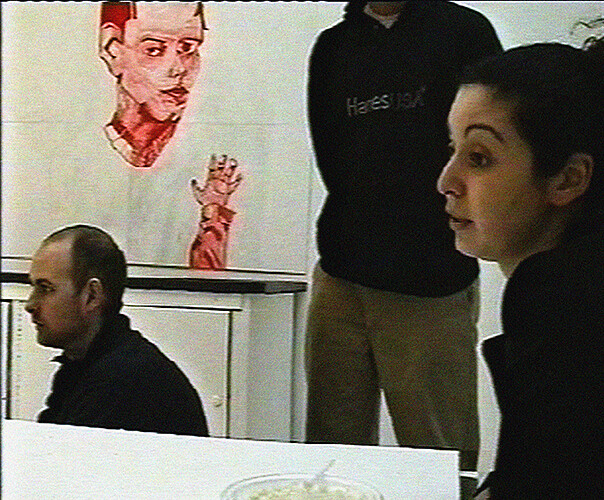As in Keren Cytter’s previous work, “Video Art Manual” strings together clichéd, Freudian-tinged narratives with a bad case of ADHD. Comprising four videos and a series of peripheral drawings, “Video Art Manual” is the stuff masochistic art critics live for: as soon as one eye rolling-worthy moment passes, such as a misogynistic character announcing his unprecedented hatred of both ducks and women (they way the talk, the way they walk!), Cytter blasts off with another libidinal oddity, laboring her viewers to glean any sense of comprehension from her work.
Behind a black curtain cordoning off the rear of Zach Feuer’s Chelsea space are a cacophony of projections, ballads, and dramaturgies making up Cytter’s video efforts from the last two years, with one exception from 2002. The soundtrack to the exhibition’s title video blares a MIDI-version of the melody to Guns N’ Roses’s “November Rain,” which is interspersed with rapid-fire human speech. In the back gallery is Cytter’s Hottest Day of the Year, a piece from 2010 riffing off documentary-style filmmaking. In the first half, the video tracks the imaginary Anne-Marie Baptiste and her family from country to country amidst the early 20th century, while the second half confusingly centers around two women working in an office of the Israeli Defense Force. Whether these two sections are connected in their narrative content is anyone’s guess, though one could assume that Cytter’s primary concern is to consider the tropes of documentary filmmaking itself.
Family (2002) another older and more brief video shown on a monitor, films the Freudian feuds of an absurdly-cast gang of characters in what is supposed to be a family in their domestic interior. Male voices are poorly dubbed over footage of female actresses playing male parts, etc. A typical conversation goes as such: “Mother, my little brother wants to mate with you. I used to want to mate with you. Now I find comfort in other women. Give me food and money!” Just as voice and speaker become physically estranged and disoriented, so too do these clichéd Freudian narratives wrestle with moments of clarity, revelation, absurdity, and disgust.
More substantial is the four-part Avalanche (2011) a 32-minute video offering a glimpse into the daily life of the hopelessly misogynistic Simon and his nameless Francophile girlfriend. Through outbursts, episodes of sex, and light domestic violence, Simon mutates between two characters of roughly similar appearance. Especially telling is a flashback in what is presumed to be the character’s past: his meticulous old piano teacher scolds him for “doing something wrong, really really wrong! Don’t do it!” Coming back to haunt an older Simon, this exact sentence is echoed later by a woman during a chance street encounter. Later in the video are three groups of people on a street in Berlin’s Neukölln neighborhood: first, a man reviewing the Canon EOS 7D camera, touting its technical abilities; a pair of men debating the merits of moving to Berlin; and lastly, we see Simon and his girlfriend engaging in some more fighting. Also bearing moments of virtuous beauty, Avalanche succeeds in its length—and after the first headache-inducing moments of self doubt while watching it (why don’t I get this?!), the viewer will come to realize that its content lies in the larger, glossed-over picture.
Last, and arguably less successful, is Cytter’s latest work, Video Art Manual. Not surprisingly, the work acts as a sort of manual demystifying the constructs of videography by highlighting them in their own form. Amidst a shot of a man walking through an empty lot at sunset and holding a gun, words scroll at the top of the screen, “Subtitles appear as a translation of the content or as independent information.” The next cut is a clip of a news broadcast on heightened solar activity. Additional scenes include archival footage of fitness guru Richard Simmons and friends shimmying their way onstage, overdubbed by the aforementioned Guns N’ Roses tune, as well as a fake surveillance clip of a man shooting what appears to be his girlfriend or even an interrogation suspect, some hipsters dancing on a roof of Berlin, etc.
While Cytter has opened up her practice as more meditative and analytical with this video, it inevitably walks the fine line of devolving into intellectual kitsch. Critics thus far have rightly taken issue with Cytter’s apparent nostalgia for postmodernist and nouvelle vague artistic strategies, specifically by using fractured narratives. However, are these didactic strategies simply blacklisted by critics for their association with scarf-wearing pseudo-intellectuals? It doesn’t seem fair to assume Cytter’s intentions are as simple as desiring to appear intellectual, mysterious, or sexy. If anything, her videos could be seen as reflecting a commonly shared, perhaps non-critical desire to speak in such a codified parlance, which stays true to her stated goal of parsing out the traits of videography—a video art manual, if you will. Whether that is a worthy task to undertake remains to be seen.





